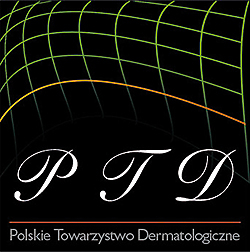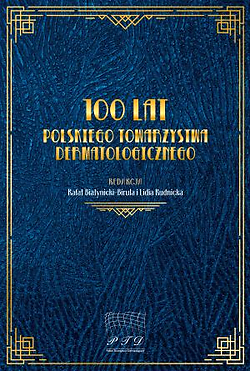Introduction
Bullous pemphigoid (BP) is indeed one of the most common autoimmune blistering diseases with complex etiology, and it primarily affects elderly individuals aged 70 years and older [1]. BP can be triggered or exacerbated by several factors, primarily comorbidities, medications, infections and physical factors, including trauma and surgery [2].
Classic BP is characterized by tense blisters located on normal or on erythematous and edematous background [1]. Typical predilection sites are flexural areas, abdomen and lower limbs [3]. Bullae are filled with serous fluid and accompanied by intense pruritus [4]. Sometimes hemorrhagic vesicles and tense bullae with excoriations and erosions may occur. Nikolsky’s sign is negative. Mucosal involvement is rarely reported [3]. In addition to classic form, BP has various atypical variants such as prurigo nodularis-like, prurigo-like [5], erythrodermic [6], ecthyma gangrenosum-like [7], intertrigo-like, dyshidrosiform [8], eczematous, localized and toxic epidermolysis-like lesions [9]. Very rarely BP can be also seen on seborrheic areas, as the scalp, pre- and postauricular, auricular areas or the chest, and in such location it is referred to as seborrheic pemphigoid (SP) [10]. Very few cases of SP have been reported in the literature. We report a rare case of SP.
Objective
Presentation of a rare case of SP with a literature review.
Case report
We present the case of a 41-year-old Polish woman who was referred to our clinic with a 10-week history of recurrent erythematous macules, vesicles and bullae filled with serous fluid or hemorrhagic fluid and distributed on the skin of the face, scalp near the frontal hairline (fig. 1) and the chest (fig. 2). The patient reported that first skin lesions appeared on the face and scalp, then on the chest. These locations are typical seborrheic areas. Vesicles were present both on the erythematous skin and on apparently unchanged skin. Some of the lesions, mainly on the scalp, were covered by crusts. Pruritus in visual analog scale (VAS) score was 7/10.
The patient had been previously diagnosed with seborrheic dermatitis (SD). Topically applied hydrocortisone, natamycin, neomycin and mometasone, which are standard treatment in SD, did not bring any significant improvement. The patient had a positive medical history of thyroidectomy due to nodular goiter a few years before and was taking levothyroxine at a dose of 75 µg and hormonal contraceptives on a regular basis. During the diagnosis she had euthyroid. She denied any other health issues.
Persistent skin lesions prompted the patient to visit the Department of Dermatology and Venereology. Physical examination revealed the highest density of macules and bullae on the erythematous and unchanged skin, above the jugular notch of the sternal manubrium in the area of the thyroidectomy cicatrix (fig. 3). Single erosions from burst blisters were also present on her skin of her chest. Nikolsky’s sign was negative. No other significant cutaneous or mucosal lesions were observed.
Laboratory tests did not show any significant deviations. 5 mm punch biopsy specimen was taken from the active lesions and submitted for histological examination, which revealed subepidermal blister and eosinophilic inflammatory infiltrate at the dermal-epidermal junction. The direct immunofluorescence test (DIF) of the perilesional skin revealed the deposition of IgG (+) and C3 (+++) along the basement membrane zone (figs. 4, 5). Salt split skin test (ssIIF) also showed IgG linear reactivity with the epidermal part of the artificial blister (fig. 6). The indirect immunofluorescence test was negative (BIOCHIP, Euroimmun, Germany). In the enzyme-linked immunosorbent assay (ELISA) (Euroimmun, Germany) BP180-NC16a and BP230 test autoantibodies were not found.
Seborrheic pemphigoid was diagnosed based on the clinical presentation, histologic and immunologic findings. Implemented treatment with oral prednisone at a dose of 0.5 mg/kg/day and gradually tapered to a final dose of 20 mg daily and topical steroids resulted in the significant improvement with the resolution of the skin lesions. After 3.5 months of continuous treatment, the patient achieved complete remission.
Discussion
Seborrheic pemphigoid clinically resembles pemphigus erythematosus, due to characteristic bullae and erosions covered by crusts [11]. The first case of this variant of pemphigoid was described in 1969 by Schynder [12]. DIF of perilesional skin shows deposition of IgG and C3 at the dermo-epidermal junction [11] and indirect IF can detect antibodies against basement membrane zone in the patients’ sera [13]. In our case, the atypical clinical picture was confirmed by positive DIF however, anti-BMZ autoantibodies were not detected in the serum of our patient. The absence of a positive IIF result could be due to a low concentration of circulating anti-BMZ autoantibodies. Moreover, the absence of antibodies to BP180 NC16a and BP230 (Euroimmun, Germany) suggests that the target epitope might be located in other regions of BP180 or BP230 [14]. Another consideration is the possibility of cross-reactivity with other proteins or molecular mimicry. There have been occasional reports of pemphigoid disease cases displaying both IgG and IgA antibodies against multiple autoantigens, such as BP180 and laminin-c1 (p200), potentially due to the epitope-spreading phenomenon [15]. ELISA tests use specific fragments or recombinant forms of BP 180 and BP230, which might not include all potential epitopes. Therefore ELISA or BIOCHIP tests can be negative, whereas the salt-split skin (ssIIF) test can be positive. The ssIIF test can detect a wide range of autoantibodies directed against various components of the basement membrane zone. In a comparative study the sensitivity of the serologic tests in pemphigoid was 88.8% in contrast to DIF and salt-split skin, whereas the sensitivity was significantly higher, 98% and 100%, respectively [16].
The exact reason underlying this condition is not fully elucidated. Goldberg et al. found that the highest expression of BP antigen was in the typical predilection sites of lesions especially in flexural surfaces and suggested that distribution of BP antigen can play a role in the localization of skin lesions [17]. There is a possibility that the expression of BP antigens is increased within the seborrheic areas, where typical vesicles and bullae occur [10].
Another hypothesis of specific localization of lesions in this condition refers to Malassezia spp. growth in seborrheic areas. Malassezia can interact with the complement system including alternative and classical pathways. These pathways are involved in complement-mediated inflammation [18]. Excessive sebum secretion or concomitant SD may also contribute to disease progression as a Koebner phenomenon [19]. The triggers which can implicate in the disease onset of the BP consist of trauma, burns, radiotherapy, ultraviolet (UV) radiation and various drugs [14]. In our patient thyroidectomy may not be a trigger factor of the disease, because it had been performed a few years earlier and the scar had healed properly. Moreover, first skin lesions occurred on the face and scalp, and later on the scar in the neckline.
SP should be differentiated from pemphigus erythematosus, SD or impetigo and immunological tests are necessary to make the correct diagnosis [11]. In differential diagnosis, the assessment of the Nikolsky’s sign may be crucial since it can be negative in SP, as in the described patient, unlike the vast bulk of cases of pemphigus erythematosus.
Due to a very low incidence of this disease, treatment is not fully established. The patient was treated with small doses of oral glucocorticoids and achieved clinical remission, which is consistent with earlier reported cases [11, 20].
Conclusions
We present this case to draw attention to rare forms of pemphigoid, which are a common diagnostic challenge. For patients with this type of lesions, if there is no improvement after standard treatment for SD, the diagnostics should be extended.
Funding
This research was funded by the research projects of Medical University of Lodz: No. 402 503/1-152-01/503-11-002.
Ethical approval
Not applicable.
Conflict of interest
The authors declare no conflict of interest.
References
1. Miyamoto D., Santi C.G., Aoki V., Maruta C.W.: Bullous pemphigoid. An Bras Dermatol 2019, 94, 133.
2.
Deotto M.L., Spiller A., Sernicola A., Alaibac M.: Bullous pemphigoid: an immune disorder related to aging. Exp Ther Med 2022, 23, 50.
3.
Schmidt E., della Torre R., Borradori L.: Clinical features and practical diagnosis of bullous pemphigoid. Dermatol Clin 2011, 29, 427-438.
4.
Khandpur S., Verma P.: Bullous pemphigoid. Indian J Dermatol Venereol Leprol 2011, 77, 450-455.
5.
Schmidt E., Sitaru C., Schubert B., Wesselmann U., Kromminga A., Bröcker E.B., et al.: Subacute prurigo variant of bullous pemphigoid: autoantibodies show the same specificity compared with classic bullous pemphigoid. J Am Acad Dermatol 2002, 47, 133-136.
6.
Korman N.J., Woods S.G.: Erythrodermic bullous pemphigoid is a clinical variant of bullous pemphigoid. Br J Dermatol 1995, 133, 967-971.
7.
Geiss Steiner J., Trüeb R.M., Kerl K., Mühleisen B., French L.E., Hofbauer G.F.L.: Ecthyma-gangrenosum-like bullous pemphigoid. Dermatology 2010, 221, 142-148.
8.
Cohen P.R.: Dyshidrosiform bullous pemphigoid. Medicina (Kaunas) 2021, 57, 398.
9.
Shakhashiro M., Bradley T.R., Tobin S.: Bullous pemphigoid in a centenarian male simulating toxic epidermal necrolysis. Cureus 2023, 15, 45037.
10.
Castro-Forés L.L.O., Cruz J.M.L., Jamora M.J.J., Canlas-Estrella K.M.: Seborrheic pemphigoid. JAAD Case Rep 2016, 2, 80-83.
11.
Errichetti E., Stinco G., Pegolo E., di Meo N., Trevisan G., Patrone P.: Seborrheic pemphigoid. Case Rep Dermatol Med 2014, 2014, 768217.
12.
Schnyder M.U.: Seborrheic pemphigoid. A new nosologic entity? Bull Soc Fr Dermatol Syphiligr 1969, 76, 320-320.
13.
Tamaki K., Furuya T., Kubota Y., Uno A., Shimada S.: Seborrheic pemphigoid and polymorphic pemphigoid. J Am Acad Dermatol 1991, 25, 568-570.
14.
Di Zenzo G., della Torre R., Zambruno G., Borradori L.: Bullous pemphigoid: from the clinic to the bench. Clin Dermatol 2012, 30, 3-16.
15.
Maki N., Hashimoto T., Yamada T., Ishii N., Tsuruta D., Demitsu T.: Case of pemphigoid with immunoglobulin G antibodies to BP180 C-terminal domain and laminin-γ1 (p200) developed after pneumococcal vaccination. J Dermatol 2021, 48, 101-105.
16.
Sárdy M., Kostaki D., Varga R., Peris K., Ruzicka T.: Comparative study of direct and indirect immunofluorescence and of bullous pemphigoid 180 and 230 enzyme-linked immunosorbent assays for diagnosis of bullous pemphigoid. J Am Acad Dermatol 2013, 69, 748-753.
17.
Goldberg D.J., Sabolinski M., Bystryn J.C.: Regional variation in the expression of bullous pemphigoid antigen and location of lesions in bullous pemphigoid. J Investig Dermatol 1984, 82, 326-328.
18.
Ashbee H.R., Evans E.G.V.: Immunology of diseases associated with Malassezia species. Clin Microbiol Rev 2002, 15, 21.
19.
Cozzani E., Gasparini G., Burlando M., Drago F., Parodi A.: Atypical presentations of bullous pemphigoid: clinical and immunopathological aspects. Autoimmun Rev 2015, 14, 438-445.
20.
Pailheret P., Courtin, Testard.: Seborrheic pemphigoid. Bull Soc Fr Dermatol Syphiligr 1959, 5, 772-773.










